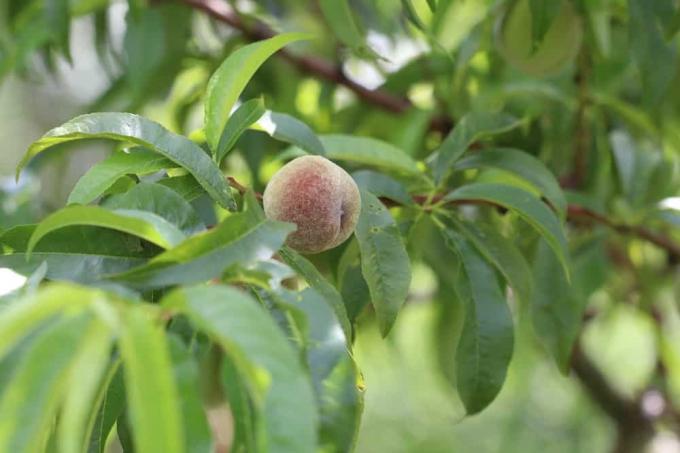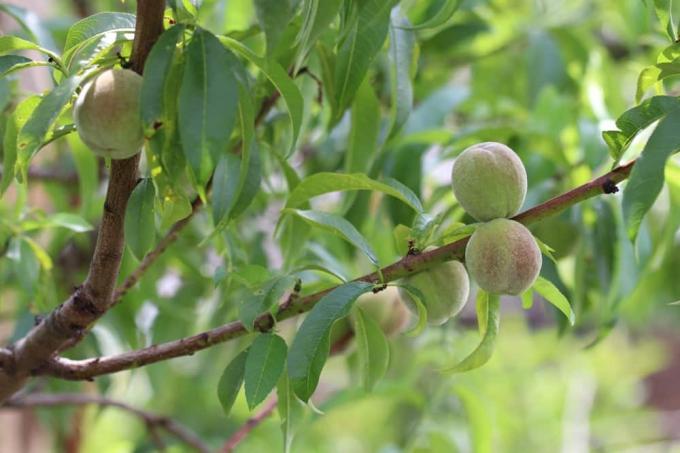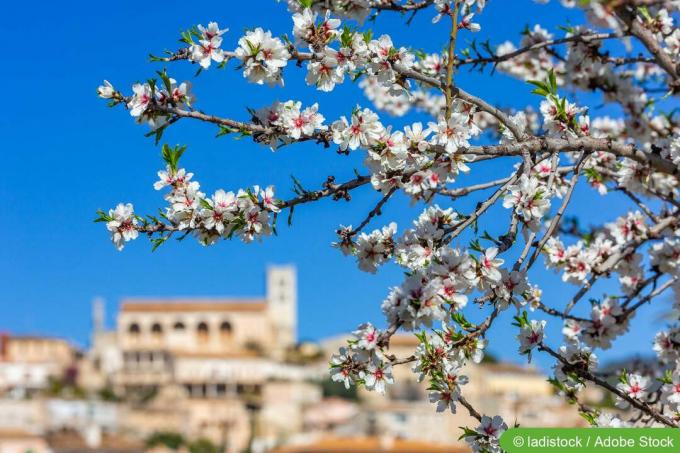

Table of contents
- background
- frizz disease
- harmful pictures
- combat
- prevention
- Other diseases
- pests
Leaves curl up and discolor - a clear indication of the so-called curling disease. It is particularly common in peach trees. In our latitudes, it is basically the biggest problem you can have with a fruit tree. Although other diseases and pests can also be dangerous to it, they play a rather subordinate role compared to curling disease.
background
Peach trees are strange plants. On the one hand, they need a lot of light and sun so that they can develop sweet, juicy fruits. On the other hand, this only works if they are exposed to the winter cold for several hundred hours over the course of a year. The reason for this is the so-called vernalization. This refers to the fact that a whole range of plants only shoot and bloom when they have to survive a longer cold period in winter. At the same time, however, relatively mild and therefore often too wet winters pose a problem for them. The wetness creates the best conditions for later being attacked by a fungus. And in the worst case, such a fungal infestation can even lead to the death of the plant or plant. of the tree.
frizz disease
This disease of peach trees is nothing more than an infestation with the fungus Taphrina deformans, a sac fungus. It penetrates the buds of the tree and infects the leaves that have not yet been able to unfold. It also overgrows the flower buds. Once this has happened, it is very difficult to stop the infestation. Without the massive use of fungicides, the disease can usually no longer be combated. Typically, an infestation occurs in spring when the previous winter was particularly wet. Taphrina deformans needs 12.5 hours of continuous wetness on the tree bark to be able to develop. The temperatures must not exceed a mark of 16 degrees Celsius.
harmful pictures
Since the fungus is first washed from the bark into the leaf buds of the tree by the rain, an infestation also shows up on the leaves. They curl up as soon as they sprout in spring. The young, green leaves also have light green or red blisters. As the disease progresses, the leaves turn whitish-green and yellowish. When the infestation has finally reached its final stage, they appear greatly enlarged, are brittle or even rubbery. Eventually they fall off. The high rate of leaf loss associated with this reduces the overall photosynthetic performance of the tree and can lead to its death.
A notice:
Curled leaves without color changes have nothing to do with leaf curl but indicate an insect infestation. Checking the underside of the leaves on which aphids can be found, for example, creates clarity.
combat
Controlling leaf curl in the peach tree is problematic. There are no home remedies or biological remedies for this. The disease cannot be controlled without the use of fungicides. The problem with this: The treatment must be carried out before the buds open. Once this has happened, even fungicides no longer help. In professional peach cultivation, the trees are therefore often sprayed prophylactically with appropriate pesticides before the buds burst. This can also be transferred to private cultivation. In a particularly mild and wet winter, the garden should therefore also be sprayed. This must take place at the end of January and then be repeated three times at intervals of about a week.
prevention

Since combating leaf curl in the home garden is often difficult, preventive measures play a crucial role. They begin with the selection of a variety that is as resistant as possible before the tree is planted. These are special breeds that are extremely robust and resilient. Among others, these include:
- Alexandra Zainara
- Amsterdam
- benedict
- Revita
- Red Vineyard Peach
It is also recommended to plant the peach tree near a house wall or to plant under an eaves. Winter rain is then at least partially kept away from the tree. Wrapping the entire tree in a sturdy plastic rot can also help, but it is very time consuming.
Other diseases
Curl disease is the most common and dangerous disease affecting peach trees. But of course there are other threats to the tree. For example, that would be worth mentioning peach scab, in which rapidly hardening dark spots form on leaves and fruit. It is easily controlled with organic fungicides. Often there is also an infestation peach mildew. It appears as a whitish coating on leaves and fruits. To combat it, infested areas should be cut off and a suitable fungicide used. This also applies if the shotgun disease appear. It is shown by small reddish spots on the leaves. After a certain time, these spots fall out of the leaf, which then looks like it has been riddled with shot.
pests
The typical diseases in peach trees are each a fungal attack. However, it can also lead to an infestation with animal pests or pests. insects come. The aphid is the most common. Leaves curl up? As already indicated, this can also indicate these little beasts. Only the use of a chemical insecticide, with which the tree must be sprayed, helps against a larger infestation. This is also done when the fruit tree spider mite appears. An infestation with these tiny insects can be recognized by the whitish spots that appear on the leaves and a later bronze-colored discoloration.
 garden editorial
garden editorial I write about everything that interests me in my garden.
Learn more about fruit trees

Life on Mallorca: highlight almond blossom
Life on Mallorca offers a lot more than sun, summer, beach and Ballermann. The beginning of the year on the popular holiday island is all about blossoming almond trees. We'll tell you when and where you can best enjoy the almond blossom on Mallorca.

Cutting sour cherries: 21 tips for the right cut
In order for a sour cherry to remain productive year after year, it must be pruned regularly. Wood that has been removed must be removed and new fruit wood must be promoted. This only works if the "editor" knows the editing rules.

Is the ornamental peach edible? | 15 tips for care and cutting
The ornamental peach can be a decorative addition to the garden as early as March, when the trees, which are up to three meters high, are in bloom. Here we tell you how to look after them and whether their fruits are edible.

20 old apple varieties | List of old apples in & around Germany
Hardly any type of fruit is as diverse as the apple. The number of apple varieties worldwide is estimated at over 20,000. Old apple varieties are those that were discovered before 1950. We have compiled a list of popular, old varieties for you.

Half-trunk cherry and apple trees: planting distance and care
Fruit trees definitely belong in every garden. But what to do if the garden is too small for a large tree? Then trees that were grown as half-stems can help. They take up less space, but deliver lots of fruit. More about this here.

Pruning a peach tree: instructions | Keeping in the pot & diseases
If there is no garden available, but you can still enjoy delicious peaches from your own cultivation should, then the peach tree can also be cultivated in a bucket and placed on the balcony or terrace become. However, care is somewhat different here than with peach trees cultivated outdoors.

